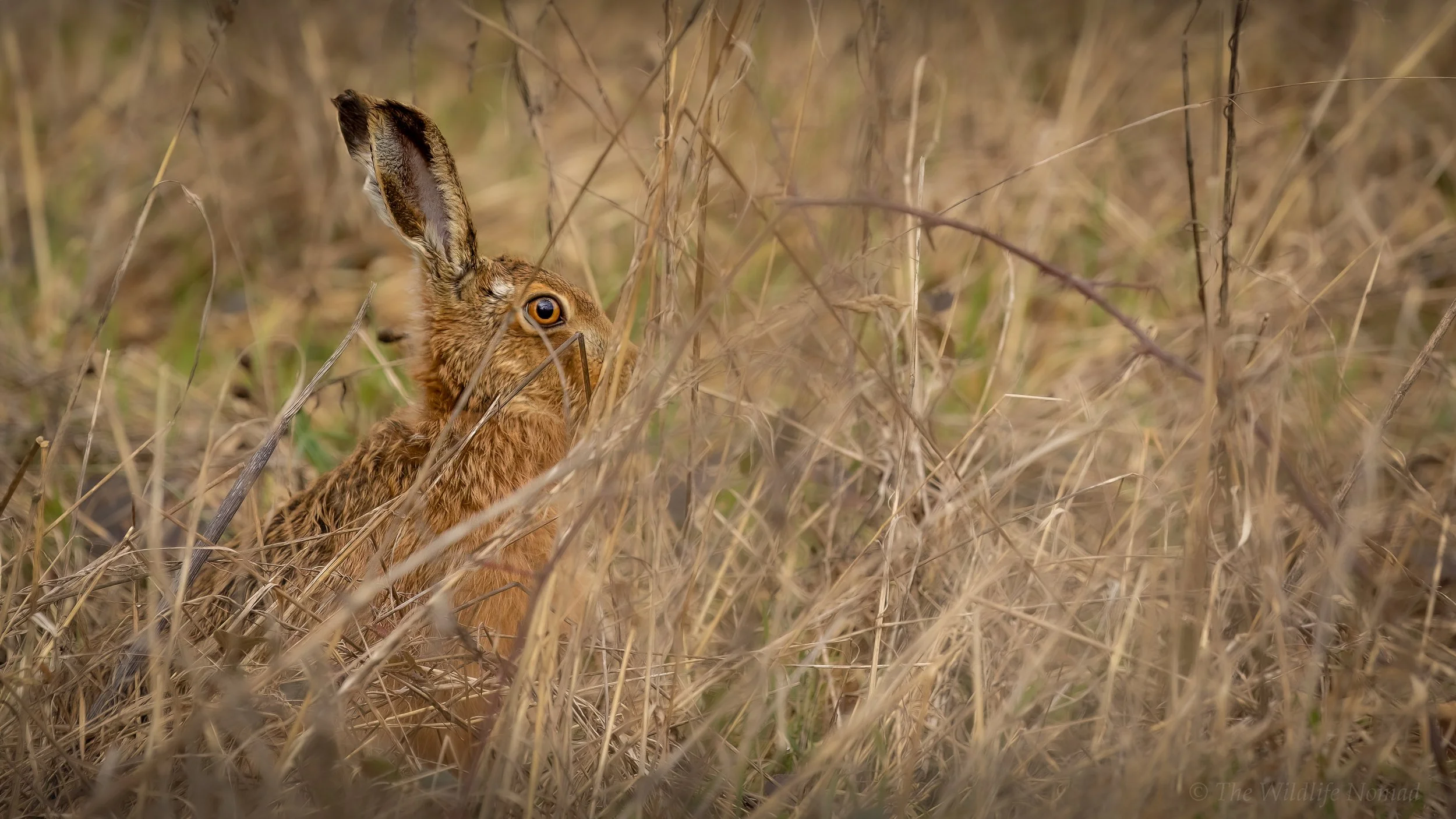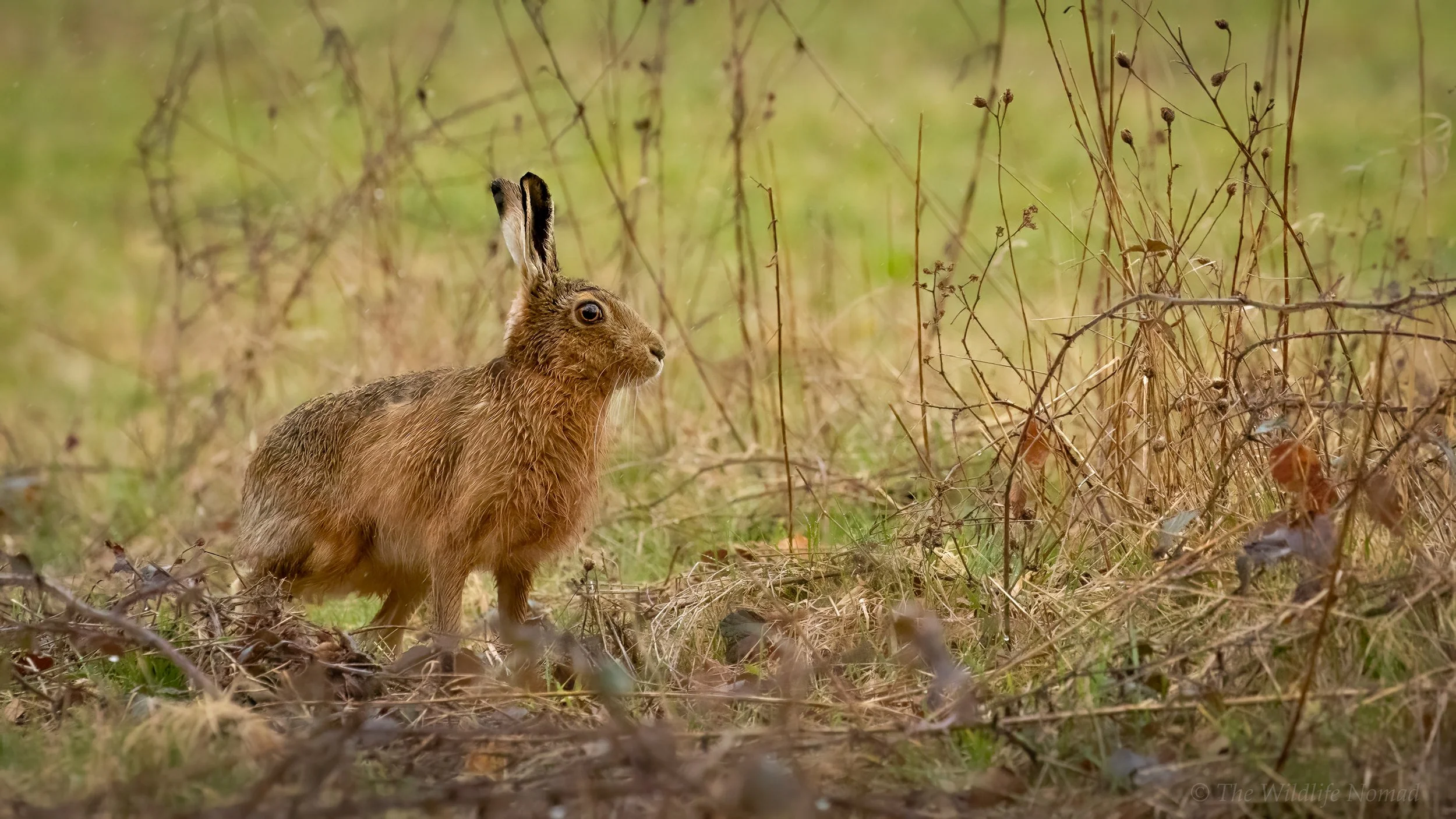Brown Hare in the UK: Behaviour, Habitat, and How to Photograph Them Ethically
The brown hare (Lepus europaeus) is one of those animals that seems to belong to another age. Long-legged, amber-eyed, and fleet as the wind, it brings a wildness to farmland that few other creatures can match. For many of us, seeing a hare bounding across a misty meadow at dawn is unforgettable, a reminder that the countryside is still home to species that live on their own terms.
For wildlife photographers and naturalists, the hare offers both challenge and reward. It is wary, swift, and difficult to approach, yet also conspicuous when it bursts into a field or boxes in spring. This guide explores the brown hare’s ecology, habitat, and behaviour, while offering practical advice on how to find and photograph it ethically in the UK.
Natural History of the Brown Hare
The brown hare is not strictly native to Britain. It was most likely introduced by the Romans, who valued it for food and sport. Yet over centuries it has become woven into our countryside, thriving in the patchwork of fields, grasslands, and hedgerows that define lowland Britain.
Unlike rabbits, which live in burrows, hares raise their young above ground in shallow scrapes called forms. Leverets are born fully furred and able to move within hours. Adults rely on explosive acceleration — up to 45 mph — and zig-zag running to escape predators.
Key adaptations include:
Long, powerful limbs for sprinting over open ground.
Large eyes set high and wide for near 360° vision.
Long ears tipped with black for acute hearing and heat regulation.
Hares feed mainly on grasses and herbs, but they readily take cereals, clover, and root crops. They are most active at night and in the twilight hours of dawn and dusk.
The “Mad March Hare”
Spring is the season when hares reveal themselves most vividly. From late February to April, males chase females across open ground. When an over-eager male presses his luck, the female rears up to fend him off with her forepaws. These dramatic boxing matches have given rise to the phrase “mad March hares.”
For photographers, this is the golden window. Hares are out in the open, active during daylight, and less wary than at other times. To watch two hares boxing in a frosty sunrise is one of the most exhilarating sights the countryside can offer.
Distribution in the UK
Brown hares are widely distributed across England, much of lowland Scotland, and parts of Wales. They are absent from the far north, upland areas, and most islands. Their strongholds remain areas of open arable farmland and mixed farming systems.
Best regions to see hares include:
East Anglia — particularly Norfolk and Suffolk’s wide arable fields.
Chalk downland in Wiltshire and Hampshire.
Lincolnshire and Yorkshire with their expansive crop systems.
Scottish lowlands and Angus where mosaics of farmland and grassland support healthy numbers.
They are less common in intensively farmed monocultures, dense forestry, or heavily urbanised areas.
Habitat and Associated Species
Brown hares thrive where food and cover are available side by side. Their ideal landscapes combine open grazing and feeding areas with rough cover for forms.
Favoured habitats include:
Mixed arable fields with cereals, legumes, and root crops.
Permanent pasture and unimproved grassland, rich in grasses and herbs.
Hedgerows, field margins, and ditches, providing shelter and resting cover.
Wildflower meadows and fallow fields, especially important for leverets.
Species you may encounter alongside hares:
Farmland birds such as skylark, lapwing, and grey partridge, which also benefit from field margins.
Predators like foxes and stoats, sharing the same hunting grounds.
Raptors such as buzzards and barn owls, often seen quartering the same fields at dusk.
Other mammals including rabbits and roe deer, which may occupy overlapping habitats.
For photographers, this makes hare-watching doubly rewarding — stake out a good field and you’re likely to encounter a suite of farmland wildlife.
Daily Routine and Behaviour
Hares are solitary for most of the year, though they form loose groups in spring. Their daily rhythm is shaped by the need to feed while avoiding predators:
Daytime — resting up in a form, often invisible until flushed. They may groom or nibble nearby vegetation.
Dusk to dawn — the main feeding window, with activity across open fields.
Patience and timing are key. Positioning yourself before dawn or at last light offers the best chance of seeing hares on the move.
Predators of the Brown Hare
Hares are built for speed, but they still fall prey to a range of natural predators:
Red foxes are the primary predator, particularly of leverets hidden in forms.
Buzzards and other large raptors take young hares when the opportunity arises.
Stoats and weasels may kill leverets in the first weeks of life.
Domestic dogs occasionally chase and kill hares, especially in open fields.
Mortality among leverets is high, with camouflage their main defence. Adults rely on running — often changing direction sharply to shake off pursuit. Seeing a hare at full sprint is one of the most striking demonstrations of wild speed in Britain.
Fieldcraft: Finding and Approaching Hares
Photographing hares is as much about patience as equipment. Their eyesight and hearing are exceptional, and they are quick to flee if they sense intrusion.
Key fieldcraft tips:
Scan before you move — use binoculars to locate hares from a distance.
Work the wind — always keep the breeze in your face.
Move slowly and smoothly — sudden movement is far more alarming than steady progress.
Use cover — hedges, ditches, and tractor lines can help you approach unseen.
Sit it out — often the best results come from staying still and letting the hare come to you.
A favourite tactic is to position yourself on the edge of a field at dawn, low to the ground, and simply wait. In time, a hare will often wander into range.
Photographing Brown Hares
Portraits and Detail Shots
Lens: 400–600mm telephoto or zoom such as a 200–800mm.
Settings: Wide aperture (f/5.6–f/6.3) to isolate the subject.
Focus: Always on the eye. Look for expressive moments when ears are pricked or eyes are lit by side light.
Behavioural Images
Boxing: Aim for shutter speeds of 1/2000s or faster. Use continuous AF and burst mode.
Grooming and feeding: Quieter behaviour that can yield intimate images if approached carefully.
Action Shots
Running hares: Try panning at 1/60–1/125s for motion blur, or freezing action at 1/2500s+.
Chasing pairs: Frame wider to capture interaction and body language.
Environmental Shots
Wide-angle or short telephoto for context — a hare as part of a misty meadow or golden stubble field can tell a stronger story than a tight portrait.
Silhouettes at sunrise or sunset are particularly effective.
Ethics in Hare Photography
Hares are highly sensitive to disturbance. The welfare of the animal must always outweigh the shot:
Avoid flushing resting hares from forms. If one bolts, you are too close.
Never pursue with vehicles or drones — this is harmful and illegal in some cases.
Stick to rights of way unless you have landowner permission.
Take extra care in spring — leverets are vulnerable, and trampling can be fatal.
A simple rule: if the hare changes behaviour because of you, it’s time to step back.
Conservation
The brown hare has declined steeply over the past century. Once numbering several million, today the UK population is estimated at 700,000–800,000. The reasons are clear:
Loss of habitat through hedgerow removal, fewer field margins, and larger monoculture fields.
Intensification of farming, with early silage cutting destroying leverets.
Pesticides and herbicides reducing the diversity of food plants.
Historic hunting and culling reducing local numbers.
Despite this, hares remain a priority species in the UK Biodiversity Action Plan. Positive management through agri-environment schemes — wider field margins, fallows, and wildflower meadows — can help populations recover.
Conclusion: Why Photograph the Brown Hare?
The brown hare is a paradox: an introduced species that feels as old as the land itself. It is abundant in folklore yet in real decline. It embodies speed and wildness, yet depends on farmed landscapes shaped by people.
For photographers, it offers both a technical challenge and an ethical responsibility. The challenge lies in stealth, patience, and timing. The responsibility lies in ensuring that the pursuit of an image never compromises the welfare of the animal.
When you sit quietly in a field at sunrise and a hare appears — ears upright, eyes alert — you are witnessing one of the most iconic sights of the British countryside. Photograph it with respect, and your images can help inspire others to value and protect this extraordinary animal.
Other articles you may be interested in:
My March 2023 “roundup” (when some of these images where taken).
Fieldcraft & Ethical Wildlife Photography
Mastering Metering & Exposure Control
———————————————————————————————-
Frequently Asked Questions (FAQ)
Where can I find brown hares in the UK?
Brown hares are most often seen in lowland farmland, meadows, and arable fields, especially in areas with hedgerows, stubbles, and uncultivated strips. Strong populations occur in East Anglia, the chalk downs of southern England, Lincolnshire, and parts of lowland Scotland.
When is the best time of day and year to photograph brown hares?
The best times are at dawn and dusk, when hares are active and light is soft. Dawn is especially rewarding as hares leave their resting forms to feed. The most dramatic behaviour, such as boxing, is seen from February to April, though hares can be photographed year-round.
What camera equipment and settings are best for photographing brown hares?
A 300–600mm lens is ideal. Use a shutter speed of at least 1/1000s to freeze movement, and an aperture of f/4–f/5.6 to isolate the subject. Continuous autofocus and burst mode are essential for fast action. A monopod or beanbag can help, but handheld works for panning.
Why do hares “box” and how can I photograph that behaviour?
Boxing is usually a female fending off a persistent male in spring. To photograph it, position yourself near active hare territories at first light, use a fast shutter speed, and shoot in bursts to capture the rapid interaction. Keep framing wide enough to include both animals.
Is the brown hare protected in the UK and what are its conservation concerns?
Brown hares are considered a game species and have limited legal protection, though some regions enforce closed seasons. Populations have fallen from around four million to fewer than 800,000 due to habitat loss, intensive farming, and pesticide use. Conservation schemes that restore field margins, wildflower strips, and fallows are key to their recovery.








